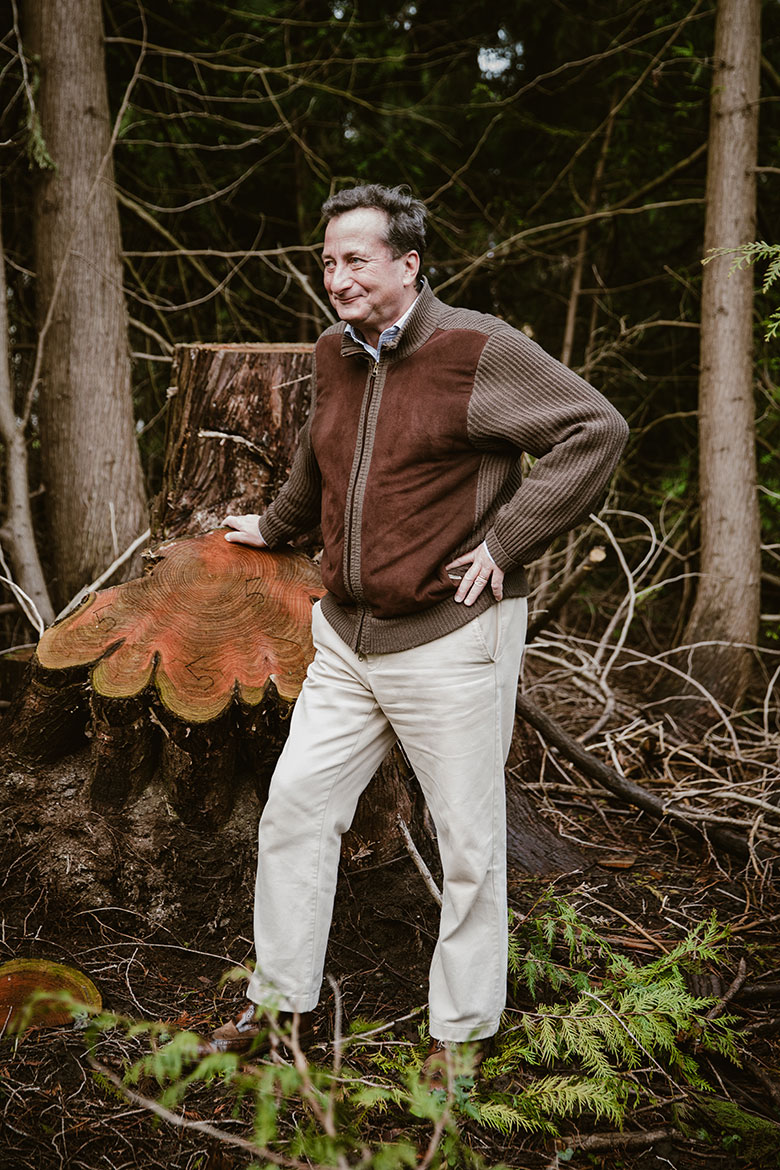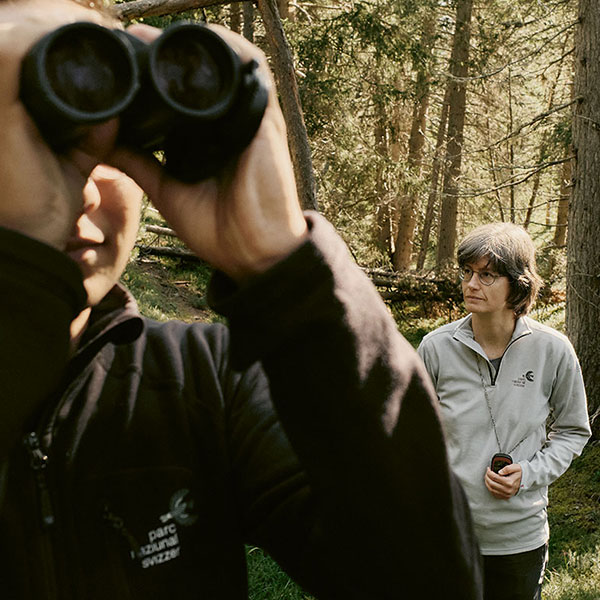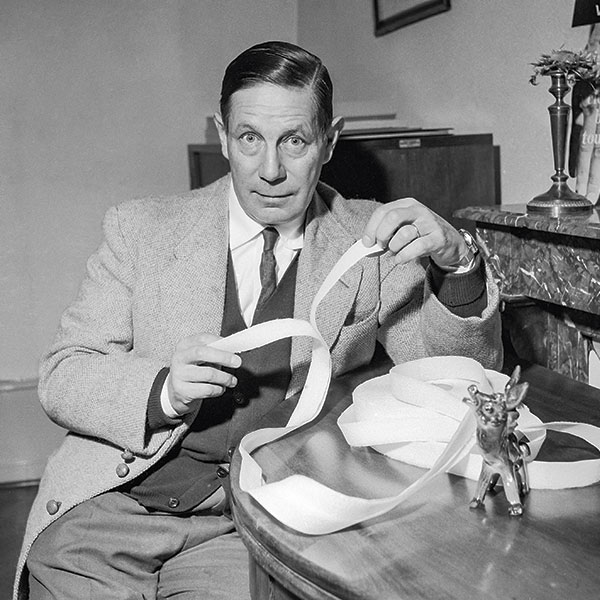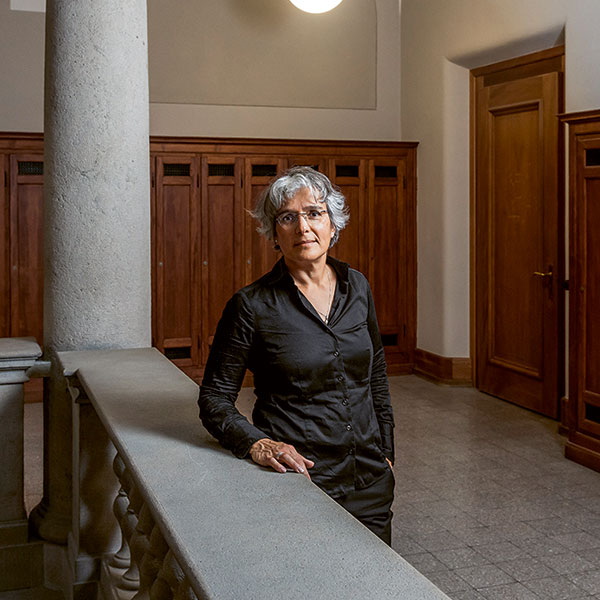Portrait
The tree whisperer
Tree ring researcher Paolo Cherubini is an unwilling adventurer. He tells us what ancient tree rings can reveal about volcanic eruptions, air pollution and the value of a viola.

Paolo Cherubini is a senior scientist in forest dynamics and dendrosciences at WSL. | Image: Anne Gabriel-Jürgens
“I’m certainly not a dog – despite roaming the forest like a stray!”, says Paolo Cherubini with a boyish grin. He’s telling us tales of a research trip to Siberia and adding all manner of technicolour detail. Up there, he says, the oil flows so abundantly that the locals are constantly heating with it. Their bedrooms are so hot that they sweat like in a banya, a Russian sauna; and they bathe in scalding hot water until their heads go red and throb. The heat is a cheap consolation on long winter days.
But Cherubini was cold there. When he arrived in the Taiga Forest at night to spend several days studying the rings of the Scots pine trees that encircle the gas flares of the oil fields (he wanted to know how the heat affects tree growth), he had to live in a wooden hut with Russian foresters at minus ten degrees Celsius and no heating. Water for washing and drinking? Only what was in a rusty bathtub outside, by the door. As a bon vivant from Tuscany, he preferred reaching for the vodka bottle. Cherubini was given a tattered couch on which to sleep that was apparently otherwise reserved for the dog. “I can still smell it”, he says, “terrible!”.
Cherubini suffered similarly when he was in Côte d’Ivoire, drilling into cocoa trees together with a student in order to look for evidence of increasing drought. In the midst of a civil war, hunched under the bushy plants, he was suddenly startled when his companion began to scream: “Ant attack!”. “That evening”, he says, “I took a shower, despite my obligatory escort of three locals with machetes, and despite the many bugs in the bathroom. I had to, because I still had red ants crawling around in my underpants!”
He’d rather be back in the office
Cherubini, 57, is an experienced researcher into tree rings and is based at WSL, the Swiss Federal Institute for Forest, Snow and Landscape Research. When he talks about his adventures, one thing quickly becomes clear: he’s no Indiana Jones. He doesn’t really feel at home in Nature, but among the mountains of paper in his office back in Birmensdorf. For 20 years, Cherubini was editor-in-chief of the journal Dendrochronologia, and he has published almost 300 scientific papers. All these articles can be found in his office, alongside printed photos of his students and family. Cherubini is not just passionate about dendrosciences – dating tree rings – but is also highly social and loves to party. He cultivates friendships around the globe and loves to eat platefuls of creamy risotto.
His workplace is a treasure trove of all he’s experienced – hardly surprising, given that Cherubini has been researching tree rings for 25 years and has been responsible for furthering the cause of dendrosciences internationally. He has been commuting from Zurich to Pisa and back for almost as long, because his wife runs a law firm in Italy. His many cross-border trips in the rickety Cisalpino train actually provide him with all the adventure he really needs, he says. Today, he keeps his expeditions “as short and as few as possible”.
You might think that tree rings are easy to count. Every child has tried it. “Lay people tend to underestimate our research”, says Cherubini. But dendrosciences naturally involve a lot more, using tree rings to study environmental influences on tree growth. This is tricky detective work that has to be undertaken in the field and in the laboratory. In addition to counting the number of tree rings, it’s also important to take their width, density and chemical composition into account. All this information adds up to provide a complete picture. To obtain tree samples, the researchers drill fine cores out of the trunks by hand. The tree is left with just a small injury, but science is provided with a potentially huge amount of data. To access this information, you need a well-equipped tree-ring laboratory. The WSL runs the second-largest such lab in the world. Here, the rod-shaped cores are cut, cleaned, X-rayed for density measurements or disassembled into their individual parts and analysed under a microscope. “The trees store information. If you understand their language, you can read them like an open book”, says Cherubini.
Predicting volcanic eruptions
Cherubini jumps from one tale to another. He loves the wealth of information that his work lets him absorb and store – which perhaps makes him rather like the trees he studies. “On one project you wake up in a tent in Patagonia among old araucaria trees and clamber over black volcanoes, while on your next trip you’re being called to give evidence as an expert in court”. Once, like a true detective, Cherubini even helped to unmask a fake Gasparo da Salò viola. “We came to the conclusion that the wood of the instrument had to be from the 18th century, i.e., from a time long after the death of the famous violin maker in 1609. That reduced the value of the viola from EUR 250,000 to about a tenth of that”, he says, smiling.
Dendrosciences have become indispensable in a wide variety of scientific fields. Analysing tree rings, for example, is the only way of accurately reconstructing past climatic conditions up to 1,000 years ago. Sometimes, Cherubini’s projects can even offer a glimpse into the future. Theoretically, tree rings could be used to predict volcanic eruptions. He has pursued this bold idea on Mount Etna, after having shown that the trees on the flank of the volcano had experienced a mysterious growth spurt shortly before an eruption. Cherubini and his colleagues were able to show why. The trees had absorbed water from Etna, shortly before the visible eruption. Before spewing out magma, it had emitted water vapour into the air, which was good for the trees. These findings are of limited use as an early warning system, because you would have to take trunk samples on a permanent basis. Nevertheless, the chemical traces in the annual rings can now help reconstruct volcanic eruptions.
Roaming the woods
Cherubini jumps to his next story. In Xi’an in China, he studied how nanoparticles are absorbed by conifers. “Many of these trees are planted to capture air pollution – as air purifiers, so to speak. We have now been able to show for the first-ever time that these nanoparticles are not only stored in the leaves, but migrate all the way to the trunk and remain there in the wood”. This makes it possible to identify areas and periods of particularly high pollution.
Again and again, Cherubini roams around his cluttered office and digs out polished discs taken from tree trunks. There’s a piece of spruce from the Dolomites that contains a cartridge from the First World War, another is 12,000 years old and was found by chance in Binz just outside Zurich, while yet another is a piece of olive wood from Santorini that is overgrown with fungus. Cherubini collected some of these wood pieces himself when he was out and about. And in fact, this is precisely what first awakened his joy in science: roaming the woods. For fun, of course, in the Dolomites. He loved the refreshing, warm, woody scent of the stone pine trees in his nostrils. That was a long way from the smelly dog’s sofa in Siberia.




